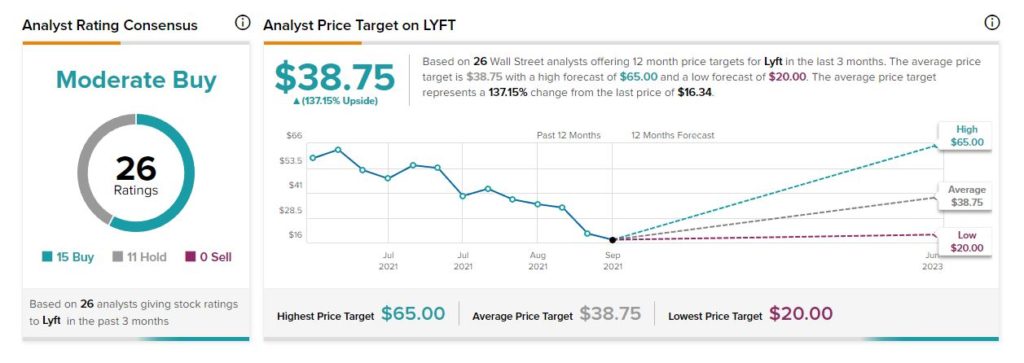Ride-sharing company, Lyft (LYFT), has significantly increased its active rider base and revenue. Hence, it could be a solid investment in this bear market.
Discover the Best Stocks and Maximize Your Portfolio:
- See what stocks are receiving strong buy ratings from top-rated analysts.
- Filter, analyze, and streamline your search for investment opportunities with TipRanks’ Stock Screener.
Lyft’s growth strategy has expanded into new markets and offered food delivery, bike-sharing, and scooter-sharing services. This strategy has allowed Lyft to compete effectively with Uber (UBER), which operates in these sectors, but not as aggressively.
Lyft operates in the U.S. and Canada only. It has a delivery platform for its drivers to pick up food, retail products, and auto parts for customers. Although Lyft does not have a dedicated food delivery option like Uber Eats, it nevertheless took advantage of the circumstances and streamlined its structure to become more efficient.
Analysts predict Lyft revenue to increase greatly in 2021 and 2022, which is a good thing to come. They also expect losses to be narrowed in the process. The interest rates are increasing, and the call for higher wages is getting louder, which means if you are not generating an acceptable profit, it will be tough to thrive. While some companies might be able to afford new contracts and additional employees, others will grapple with growing costs and diminishing returns.
Lyft is a ride-sharing company that has experienced consistent growth since its inception. The company still has a long way to grow before achieving its full potential. However, LYFT has experienced rapid growth with a high margin, which creates a compelling case for investors.

On TipRanks, LYFT scores a 2 out of 10 on the Smart Score spectrum. This indicates a potential for the stock to underperform the broader market.
Lyft Posts a Decent Rebound From Pandemic Lows
Inflation and interest rates are rising, which means that the market is not as attractive as it has been in recent times.
Hence, you should know certain things before investing your money in the stock market. One of the best things companies can do right now is performed on the bottom line.
The first-quarter 2022 earnings report ticked most boxes, except for second-quarter guidance.
Lyft reported a net loss of $196.9 million. This number compares very favorably with a loss of $427.3 million recorded last year. However, there is a caveat here. This quarter’s loss mainly came from stock-based compensation.
Stock-based compensation can help reward employees for their hard work and achievements. However, regarding asset-light tech companies, stock-based compensation is not feasible. This type of compensation has helped other technology companies grow rapidly, but it is not the best option for those with limited resources.
Lyft has been on the rise recently & is one of the fastest-growing rideshare businesses in North America. They operate in 644 U.S. and 12 Canadian cities and have had 18.73 million members since December last year.
Unfortunately, the company doesn’t have the big bucks to continue its share-based compensation expenses. This means it will have to focus on providing frugal benefits and do its best not to disappoint shareholders.
On a more positive note, revenues came in at $876 million, up 44% year on year. CEO Logan Green said that the revenue surge was due to “increased demand and resilient driver levels.”
Lyft vs. Uber
In 2020, Lyft’s revenue had decreased 35% compared to $3.6 billion in 2019. This may be because Lyft couldn’t offer a platform like Uber Eats that would drive more of its ride-hailing business.
Lyft generated $3.2 billion in revenue in 2021, a year-over-year increase of 35%. This is a decrease compared to the $3.61 billion generated in 2019. However, it’s still an excellent recovery from the heights of the pandemic.
Plus, Lyft was able to achieve adjusted profitability before Uber. This is an impressive feat, given Uber’s well-documented position in the market.
There are a few different reasons for Lyft’s path to profitability. Firstly, the ride-hailing giant is not competing with food delivery services like UberEats and Grubhub, making their business more stable. Another reason is that it has not stretched itself by expanding into low-margin markets, something which Uber did.
Hence, although still the dominant player in the U.S. ride-sharing market, Uber is seeing its market share shrink faster than that of Lyft. In September 2017, Uber had a 74% market share, but by July 2021, this had fallen to 69%.
Although Uber’s market share has declined, Lyft is picking up the slack. A study from that same month showed its market share was at 31%.
What are the Risks?
While we have talked up Lyft’s positives, it’s important to highlight certain issues why the stock is down.
In reporting its fiscal first-quarter earnings, Lyft unveiled a softer than expected second-quarter outlook. Wall Street expects the company to earn between $1.02 billion, but the company believes revenue will come in between $950 million and $1 billion.
Moreover, gas prices have surged to new levels due to the war in Ukraine. Lyft announced during its analysts call that it is investing a lot more in driver subsidies. During this quarter, many drivers should actually start earning more as the service becomes less competitive.
However, these incentives might be needed because, otherwise, drivers might leave the platform. And no ride-hailing company can afford this. Lyft’s revenue increased 44% year-over-year to $875.6 million for Q1 2022. Revenue per active rider rose 9% per active rider to $49.18.
But to keep riders happy, Lyft is paying a huge price.
Lyft lost $200 million in the first quarter of 2022 alone, and the ride-hailing giant lost $167 million in free cash flow. On the bright side, Lyft has $2.2 billion cash on its balance sheet. Therefore, it is not scrambling for capital as it navigates this tricky period.
Wall Street’s Take
Wall Street analysts see room for Lyft to continue making gains on competition from Uber. It holds a Moderate Buy consensus rating based on 15 Buys and 11 Holds.
LYFT has an average price target of $38.75 per share, representing upside of 137.15% versus the latest closing price.

The Bottom Line on Lyft
Uber has faced some significant challenges in the past few years as a rideshare company. It has had to deal with increased competition from Lyft, which has been able to capitalize on these missteps.
The biggest short-term headwind for Lyft is maintaining driver satisfaction. It can lead to profitability issues. But in the long run, once oil prices stabilize, the ride-hailing giant will continue to grow. Hence, Lyft is overall a great investment.
Read full Disclosure









